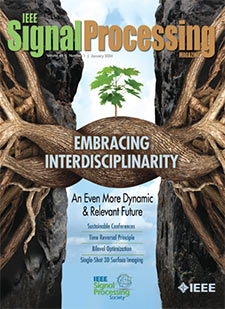- Our Story
- Publications & Resources
- Publications & Resources
- Publications
- IEEE Signal Processing Magazine
- IEEE Journal of Selected Topics in Signal Processing
- IEEE Signal Processing Letters
- IEEE/ACM Transactions on Audio Speech and Language Processing
- IEEE Transactions on Computational Imaging
- IEEE Transactions on Image Processing
- IEEE Transactions on Information Forensics and Security
- IEEE Transactions on Multimedia
- IEEE Transactions on Signal and Information Processing over Networks
- IEEE Transactions on Signal Processing
- IEEE TCI
- IEEE TSIPN
- Data & Challenges
- Submit Manuscript
- Guidelines
- Information for Authors
- Special Issue Deadlines
- Overview Articles
- Top Accessed Articles
- SPS Newsletter
- SigPort
- SPS Resource Center
- Publications Feedback
- Publications FAQ
- Blog
- News
- Dataset Papers
- Conferences & Events
- Community & Involvement
- Professional Development
- For Volunteers
- Information for Authors-OJSP
-
Home
Conferences Events IEEE JSTSP Article IEEE Signal Processing Magazine IEEE TIFS Article IEEE TMM Article IEEE TSP Article Jobs in Signal Processing Lectures Machine Learning Seasonal Schools Signal Processing News SPM Article SPS Distinguished Lectures SPS Newsletter Article SPS Webinar SPS Webinars SPS Webinar Series Webinar webinars
-
Our Story
What is Signal Processing?

The technology we use, and even rely on, in our everyday lives –computers, radios, video, cell phones – is enabled by signal processing. Learn More » -
Publications & Resources
-
SPS Resources
- Signal Processing Magazine The premier publication of the society.
- SPS Newsletter Monthly updates in Signal Processing
- SPS Resource Center Online library of tutorials, lectures, and presentations.
- SigPort Online repository for reports, papers, and more.
- SPS Feed The latest news, events, and more from the world of Signal Processing.
-
SPS Resources
-
Conferences & Events
-
Community & Involvement
-
Membership
- Join SPS The IEEE Signal Processing Magazine, Conference, Discounts, Awards, Collaborations, and more!
- Chapter Locator Find your local chapter and connect with fellow industry professionals, academics and students
- Women in Signal Processing Networking and engagement opportunities for women across signal processing disciplines
- Students Scholarships, conference discounts, travel grants, SP Cup, VIP Cup, 5-MICC
- Young Professionals Career development opportunities, networking
- Get Involved
-
Technical Committees
- Applied Signal Processing Systems
- Audio and Acoustic Signal Processing
- Bio Imaging and Signal Processing
- Computational Imaging
- Image Video and Multidimensional Signal Processing
- Information Forensics and Security
- Machine Learning for Signal Processing
- Multimedia Signal Processing
- Sensor Array and Multichannel
- Signal Processing for Communication and Networking
- Signal Processing Theory and Methods
- Speech and Language Processing
- Technical Working Groups
- More TC Resources
-
Membership
-
Professional Development
-
Professional Development
- Mentoring Experiences for Underrepresented Young Researchers (ME-UYR)
- Micro Mentoring Experience Program (MiME)
- Distinguished Lecturer Program
- Distinguished Lecturers
- Distinguished Lecturer Nominations
- Past Lecturers
- Distinguished Industry Speaker Program
- Distinguished Industry Speakers
- Distinguished Industry Speaker Nominations
- Industry Resources
- IEEE Training Materials
- Jobs in Signal Processing: IEEE Job Site
-
Career Resources
- SPS Education Program Educational content in signal processing and related fields.
- Distinguished Lecturer Program Chapters have access to educators and authors in the fields of Signal Processing
- PROGRESS Initiative Promoting diversity in the field of signal processing.
- Job Opportunities Signal Processing and Technical Committee specific job opportunities
- Job Submission Form Employers may submit opportunities in the area of Signal Processing.
-
Professional Development
-
For Volunteers
-
For Board & Committee Members
- Board Agenda/Minutes* Agendas, minutes and supporting documentation for Board and Committee Members
- SPS Directory* Directory of volunteers, society and division directory for Board and Committee Members.
- Membership Development Reports* Insight into the Society’s month-over-month and year-over-year growths and declines for Board and Committee Members
-
For Board & Committee Members
Popular Pages
Today's:
- Submit a Manuscript
- Awards & Submit Award Nomination
- Information for Authors
- (MLSP 2024) 2024 IEEE International Workshop on Machine Learning for Signal Processing
- IEEE Transactions on Image Processing
- IEEE/ACM Transactions on Audio Speech and Language Processing
- Information for Authors-SPL
- Signal Processing 101
- IEEE Transactions on Information Forensics and Security
- Nominate a Colleague! Nominations Open for 2024 IEEE SPS Awards
- Conference Call for Papers
- IEEE Signal Processing Letters
- Video & Image Processing Cup
- (SLT 2024) 2024 IEEE Spoken Language Technology Workshop
- SPS Scholarship Program
All time:
- Information for Authors
- Submit a Manuscript
- IEEE Transactions on Image Processing
- 404 Page
- IEEE/ACM Transactions on Audio Speech and Language Processing
- IEEE Transactions on Information Forensics and Security
- IEEE Transactions on Multimedia
- IEEE Signal Processing Letters
- IEEE Transactions on Signal Processing
- Conferences & Events
- IEEE Journal of Selected Topics in Signal Processing
- Information for Authors-SPL
- Conference Call for Papers
- Signal Processing 101
- IEEE Signal Processing Magazine
Last viewed:
- SPS Scholarship Program
- Information for Authors OJSP
- Signal Processing 101
- Information for Authors
- Board of Governors
- Nominate a Colleague! Nominations Open for 2024 IEEE SPS Awards
- IEEE Transactions on Multimedia
- IEEE Signal Processing Letters
- Conferences & Events
- Integrated Sensing and Communication Technical Working Group
- Signal Processing Opens the Internet of Things to a New World of Possibilities: Research Leads to New Internet of Things Technologies and Applications
- Awards & Submit Award Nomination
- Our Story
- Conference Call for Papers
- IEEE Transactions on Signal Processing
Winners of the Student Autonomous Underwater Vehicles Challenge Announced
You are here
Newsletter Menu
Newsletter Categories
Top Reasons to Join SPS Today!
1. IEEE Signal Processing Magazine
2. Signal Processing Digital Library*
3. Inside Signal Processing Newsletter
4. SPS Resource Center
5. Career advancement & recognition
6. Discounts on conferences and publications
7. Professional networking
8. Communities for students, young professionals, and women
9. Volunteer opportunities
10. Coming soon! PDH/CEU credits
Click here to learn more.
News and Resources for Members of the IEEE Signal Processing Society
Winners of the Student Autonomous Underwater Vehicles Challenge Announced
For the first time, two teams jointly won the SAUC-E competition, the Student Autonomous Underwater Vehicle Challenge - Europe. The ENSTA Bretagne team, with the robot SAUC-ISSE, and the DFKI GmbH-University of Bremen team, with the robot Avalon, triumphed over four other teams at the 9th edition. The 2nd prize went jointly to the ENSTA Bretagne team, with the robot CISSAU, and to University of Applied Sciences Kiel, with the robot TomKyle, which was awarded as well for the “Best Journal Paper”.
[gallery]
The other prizes were awarded to the Robdos/UPM team, from Spain, that won the “System Integration Award”, and the Scuola Superiore Sant’Anna team, from Italy, that won the “Versatility Award”.
Three teams out of six were at their first participation in SAUC-E.
The competition was hosted from 20 to 26 September for the 5th time in a row by the NATO Centre for Maritime Research and Experimentation (CMRE), and the Award Ceremony was held for the first time downtown in La Spezia during the European Researchers’ Night on 26 September 2014.
Each year SAUC-E challenges multidisciplinary University teams (consisting at least of 75% students members) to design and build Autonomous Underwater Vehicles (AUVs) capable of performing realistic missions. The students’ AUVs must perform a series of tasks autonomously facing real life conditions such as limited visibility in the sea, with no control, guidance or communication from a person or from any off-board computer including GPS systems.
For the first task, an AUV (Autonomous Underwater Vehicle) has to pass in the middle of two submerged buoys after covering a path in autonomous navigation. Other tasks consist in the AUV following a wall and inspecting an anomaly (a submerged buoy with a flashing light on the top), inspecting an underwater structure and in localizing a black box containing an acoustic pinger.
Collaboration between vehicles is strongly encouraged. The AUV can call a collaborator surface vehicle via an acoustic message to cooperatively solve some tasks.
"We are excited by the results" says Gabriele Ferri, the SAUC-E Technical Director, "We had different teams capable of getting points in complex tasks showing us an improvement in the overall team performance over the last years. Furthermore, two teams were successful in adopting cooperative strategies. We are happy of that since we believe that realizing smart cooperative robots will be the great challenge for the research in the next years".
From 29 September to 3 October 2014, for the first time CMRE will also host the euRathlon sea robotic challenge. The challenge is the second event of the euRathlon project, a three-year effort, funded by the European Commission, where robots and their teams of designers go head-to-head in a series of demanding outdoor scenarios that mimic the real challenges of a disaster situation. In 2015, the final Grand Challenge will feature all three elements (land, sea and air) to respond to a mock disaster scenario inspired by the Fukushima accident.
Competition scenarios for euRathlon 2014 have been designed to lead up to the Grand Challenge and will consist of five different marine scenarios: “Long range autonomous underwater navigation”, “Environmental survey of the accident area”, “Leak localisation and structure inspection”, “Interaction with underwater structures” and a “Combined scenario”.
Teams and their robot vehicles may compete in one or more scenarios. All scenario tasks can be undertaken by a single AUV. However, in some scenarios a team can compete using only an Unmanned Surface Vehicle (USV), or a combination of USV and AUV.
Both SAUC-E and euRathlon competitions encourage participants to think about sea robotics and related applications while fostering innovation and technology. Thanks to the link between the two events and the possibility to loan vehicle related to euRathlon, two teams successfully participated in SAUC-E without previous experience in marine robotics.
Open Calls
Research Opportunities
Conference News
Society News
- Member in the Spotlight: Neil Wachowski
- IEEE SPS 2014 Members-at-Large and Directors-at-Large Election Results
- IEEE Dues Change for e-Membership
- Call for Nominations: Fellow Reference Committee
- Call for Nominations: IEEE Technical Field Awards
- Call for Nominations: Chapter of the Year
- Watch the 2014 IEEE Honors Ceremony on IEEE.tv
- Call for Nominations: N&A Committee and Awards Boards
- IEEE Annual Election: Last chance to Vote: Deadline 1 October
Initiatives & Trends
Chapter & DL News
PhD Theses
Education & Resources
Publications News
New Books
SPS on Twitter
- DEADLINE EXTENDED: The 2023 IEEE International Workshop on Machine Learning for Signal Processing is now accepting… https://t.co/NLH2u19a3y
- ONE MONTH OUT! We are celebrating the inaugural SPS Day on 2 June, honoring the date the Society was established in… https://t.co/V6Z3wKGK1O
- The new SPS Scholarship Program welcomes applications from students interested in pursuing signal processing educat… https://t.co/0aYPMDSWDj
- CALL FOR PAPERS: The IEEE Journal of Selected Topics in Signal Processing is now seeking submissions for a Special… https://t.co/NPCGrSjQbh
- Test your knowledge of signal processing history with our April trivia! Our 75th anniversary celebration continues:… https://t.co/4xal7voFER
Home | Sitemap | Contact | Accessibility | Nondiscrimination Policy | IEEE Ethics Reporting | IEEE Privacy Policy | Terms | Feedback
© Copyright 2024 IEEE – All rights reserved. Use of this website signifies your agreement to the IEEE Terms and Conditions.
A not-for-profit organization, IEEE is the world's largest technical professional organization dedicated to advancing technology for the benefit of humanity.








